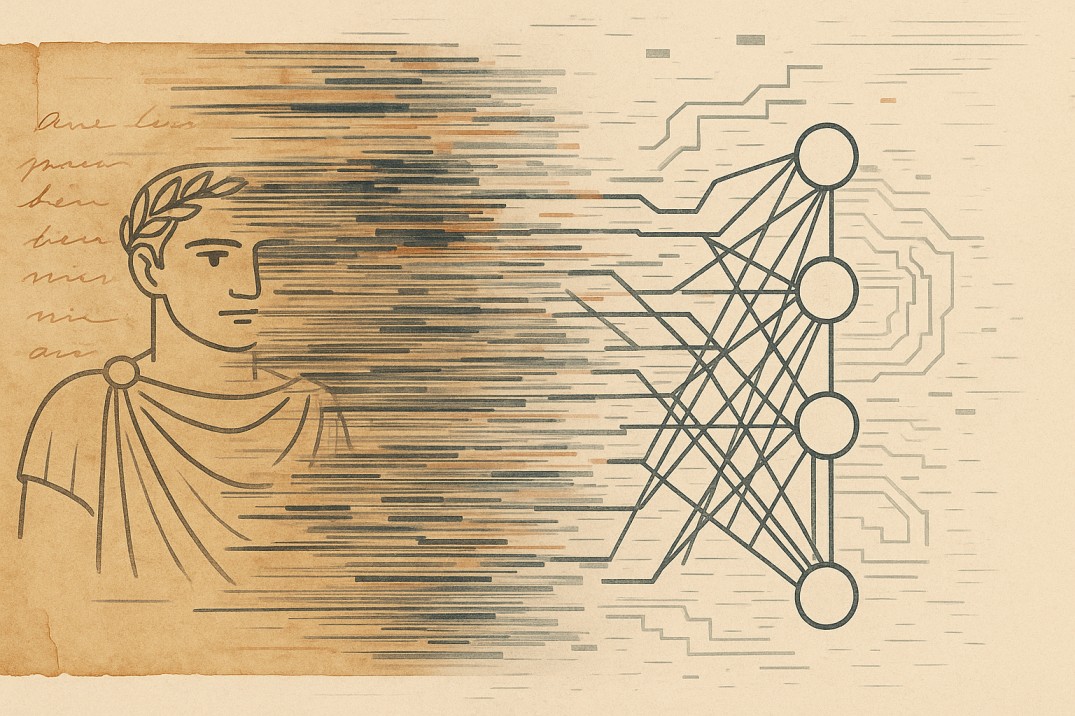The AI as secret agent to uncover hidden archaeological artefacts
AI’s Role in Artifact Identification
The use of AI in archaeology goes back to 2016, with the appearance of the ARCHAIDE application, an automatic scan-recognition system for ceramic fragments generated by artificial intelligence. The contribution to the research projects was immense, and the time saved in sorting remains is remarkable. The potential of this tool paves the way for more advanced identification of artifacts, right up to their reconstruction in 3D models later on.
It's rare for an archaeologist to discover an intact object in good condition. Generally, excavations are mainly concerned with fragments, the identification and reconstruction of which is particularly time-consuming and tedious. However, AI algorithms can analyze the shapes and decorations of fragments using predefined models. To allow a virtual reconstitution.
Decoding Ancient Scripts: AI’s Breakthroughs in Translating Historical Texts
In 2023, a multidisciplinary Israeli team developed software capable of deciphering and translating into English Antik Akkadian texts engraved on clay tablets. The program is particularly powerful, as Mesopotamian writings are mostly engraved in the same generalization of typology. The level of deciphering accuracy for Greek texts, on the other hand, is particularly satisfactory. Ithaca, a tool developed by DeepMind, was able to achieve a 62% accuracy rate in the restitution of a lacunar Greek text.
In February 2024, three students from the University of Kentucky (USA) succeeded in getting an AI to decipher 5% of a text inscribed on a papyrus scroll considered unusable. The document, baked but not burnt during the eruption of Mount Vesuvius in 79 AD, is impossible to unroll without being destroyed. The combination of 3D scanning with X-rays, followed by the identification of the virtually unrolled images by AI, enabled the identification of around a hundred Greek letters. Although the restitution may seem minute, it nevertheless provides researchers with information that was previously inaccessible. A precious asset for archaeological research, the temptation to use AI to help researchers interpret information is great.
Robotics and AI in Restoration: The REPAIR Project Case Study
Back In 2020, the European Union decided to fund the REPAIR PROJECT (Reconstructing the Past: Artificial Intelligence and Robotics) project, which is working on an autonomous robotic system capable of assembling fragments to restore the artifact. Equipped with a mechanized arm and a scanner, the robot relies on identification software to associate the pieces of an object with the precision of a human being, but in record time. The intelligence was tested on the frescoes on the painted ceiling of the Casa dei Pittori in the ancient city of Pompeii.
The robot analyzes the frescoes and proposes an interpretation to the archaeologists, who then check its coherence. If the interpretation doesn't seem plausible, robot analyzes and proposes a decipherment to the archaeologists, who check its coherence. If the interpretation does not seem plausible, the robot repeats its analysis and proposes a new combination. In 2022, at the University of Bristol in Great Britain, researchers used AI to determine what spherical stones found on the island of Santorini, Crete, and Cyprus might correspond to. After analysis, the tool suggested that the stones, of two distinct sizes, had been deliberately chosen for their shape and weight.
Based on their location, with the larger ones deposited in artificial cavities beneath the dwellings, the AI thought it was a board game, whereas the researchers were thinking more along the lines of throwing balls, a counting system, or the pawns of a game!
However, the risk of drift cannot be ruled out. AI, which is particularly effective at identifying from what it knows, does not yet have the ability to resonate. It does not take into account notions of culture, belief, or artistic sensibility. It remains a tool to help with determination and must still be combined with human expertise to avoid errors.
The Limits of AI in Archaeology
There are also limits to AI help, as the human mind is, until now, and probably not in some years to come, the only one to make real deductions on an artefact's construction and origin: the best example is the one of the Antikythera mechanism. The device is the first ancient analog calculator used to calculate astronomical positions.
It's a bronze mechanism comprising dozens of interlocking cogwheels arranged in several overlapping spheres and was used to calculate the moon's and the sun's positions as well as the stars alignments for navigation and agricultural purposes. It has 355 holes due to the lunar cycle.
Discovered in 1901 in the wreck of a ship going ou coming from Alexandria to Kreta, As I exposed it in one of my conferences, my assumption is that this advanced device was created by Aristarchus of Samos, the Greek scientist and astronomer, also the chief « mekanikos » (inventor of animated machines) of the Pharaoh Ptolemy II of Egypt.
He was also the first to discover that the sun was the center of our space and not the earth, which was forgotten until Copernicus! There is also the incredible story of an ancient artefact who eludes exact dating until now, which I was able to get in an American auction house some years ago.
I would definitely look forward to any AI help or expertise to date this antique masterpiece I will describe now: It looks like a low-carat gold ring on bronze or high-finish gold-bronze with ordinary bronze for the two inner rings. The gold band, hammered onto a bronze pattern, seems to have fit an ancient wooden scepter, whose wood disintegrated since the millennia.
History: Among the ancient Greeks, the scepter (Ancient Greek: σκῆπτρον, skeptron, "stick, staff") was a long staff, such as the one Agamemnon brandished (Iliad, I) or was used by respected elders (Iliad, xviii. 46; Herodotus/196), and came to be used by judges, military leaders, priests, and others in positions of authority. It is depicted on painted vases as a long staff with a bronze metal ornament.
When the scepter is carried by Zeus or Hades, it is steered by a bird, most likely an eagle. It was this symbol of Zeus, king of the gods and ruler of Olympus, that gave inviolable status to the « kerykes, » the heralds, who were thus protected by the precursor of modern diplomatic immunity.
When, in the Iliad, Agamemnon sends Ulysses (Odysseus) to the chiefs of the Achaeans, he lends him his scepter. The X-ray fluorescence (XRF) analysis shows a bronze mixture. Dating to the late Archean Bronze Age (approx. 1300-1400 BC) On ancient Greek antique vases, the Greek (Kylyx & Kraters) king Agamemnon of Mycenae is holding the BANDED SCEPTRON. A gold and bronze banded ornament is enrolled upon a wooden scepter.
Symbolizing the authority of the Greek warrior king. (In reality, on the archeological piece, the wood has long since disappeared, of course.) The description of this once-lost treasure: A figure is seated on a horse, on a throne, on a dolphin, or on a beast—bulls and lions and other scenes are sculpted on the golden artefact (see photo of the author).
The finder and previous owner was Louis Di Lauro; he bought it at a US auction where it was listed as a relic of the Mohenjo Daro culture. I agree with most of his identifications for the rest of his collection, but this one didn't look like it belonged there at all! (Howard G. in New York) described it as gilded pewter, but the streak test was negative. And the mythological scenes don't match at all with ancient Indian craftsmanship or depictions.
The seated figure with a bandaged staff, astride on the dolphin tail, looks like a Greek king of the sea... resembling a Poseidon who is more Mediterranean, and the style is from close to Mycenae rather than further east, now Pakistan! This is a riddle maybe to be solved by AI or more intensive research. As the tests made from 2017 to 2022 did only conclude to an approximate datation, not a clear identification. Except that it is Archaean, not Indian. Ancient secrets are yet to be revealed on this incredible masterpiece, bringing mythology to reality!


.png)



.jpg)


